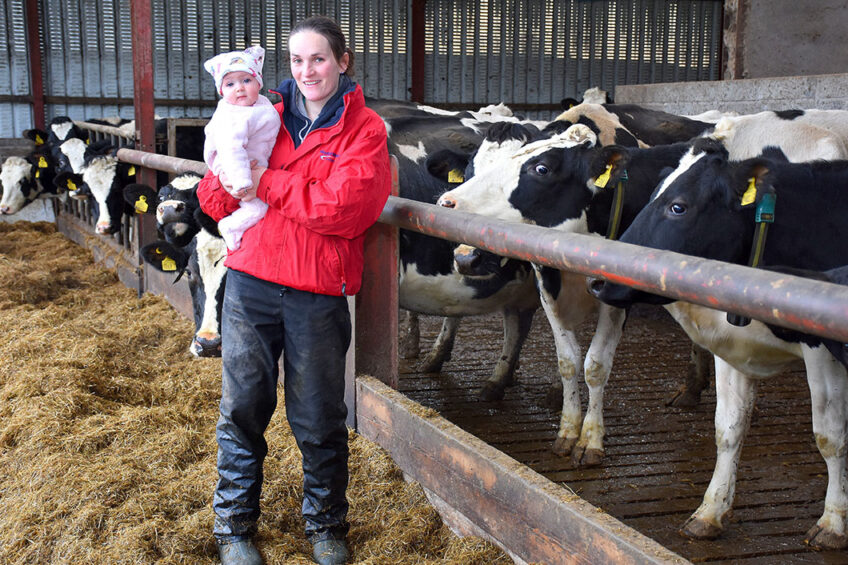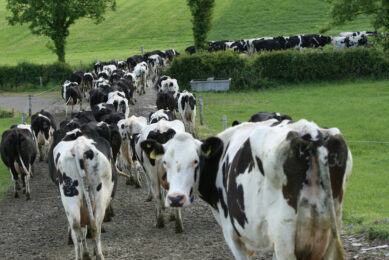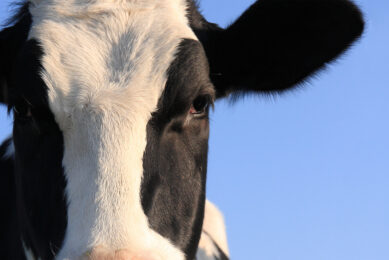Farm report, Ireland: Balancing farm and family

Dairy farm succession can be a touchy subject among families and usually involves a son taking over the operational duties from his father. However, more females these days are stepping up and running the family farm with some opting to mix farm management with raising children at the same time.
Balancing work and family
One of those female farmers busy balancing a young family with daily farm work is 34 year old Caryn Webster from County Antrim in Northern Ireland.
Mum of three young children aged between six months and five years old, Caryn runs the family dairy farm down at Brown’s Bay, near Islandmagee, while husband James works full-time in nearby Kilroot power station.
The farm has been handed down to Caryn by her father Jack who still helps out with some milkings and feeding young calves while mum Caroline helps with babysitting duties.

It may be a lot of hard work for Caryn basically managing two jobs but she wouldn’t have it any other way and has plans to enhance the farm and make it more efficient.
“I wake up every morning at 5.30am to milk the cows just like most other dairy farmers have to do,” says Caryn. “The kids are prepared for school on weekdays and after dropping them off I continue working. But that’s farming life and I wouldn’t have it any other way,” she adds.
The farm
Caryn runs 65 Holstein cows on the farm and came home to work there after studying for a degree in agriculture in England and gaining work experience for a year on a dairy farm in New Zealand.

“I have been at home farming since 2008,” she said. “I am the fourth generation on the farm with my great grandfather and his brother moving here in 1876. Although the farm has been split up over the generations it now comprises of around 47 hectares of land.
“Dairying started to be more of a focus on the farm around the 1930s with Dairy Shorthorn cattle, changing in the mid-1950s to the British Friesian breed and then progressing to Holstein Friesian, as it is today.
“We are currently milking approximately 60 to 65 pedigree Holstein Friesian cows under the Bayends prefix twice a day and they are yielding an average of 7,000 litres at 4.62% butterfat and 3.73% protein.
“We milk the cows in a ten point swing over Fullwood parlour and all the milk is sold to the Dale Farm processor,” says Caryn.
“There are approximately 25 in calf heifers and a further 25 maiden heifers and calves all bred from AI in the herd each year, which is too many for our replacements and means we could be in a position to sell some in the future.”
Caryn’s cows are grazed as one group for as long as possible during the year and could be put out to pasture as early as February and as late as December though not necessarily in the same year.
On a normal day Caryn gets her two oldest boys, Benjamin and William, ready for school before taking over the milking from her dad. Once the milking is over there are other mouths to feed before Caryn can have any breakfast herself.
“Mum looks after our youngest, daughter Tilly, which is immense help,” said Caryn. “I always liked farming and it was a bit of a surprise to dad that I wanted to take over the farm instead of my brothers.
Cow numbers and new parlour
“I enjoy working with the cows even though it can be somewhat of a lonely existence being a farmer. Looking to the future my plans are really to increase cow numbers very slightly to 70.
“Although we are not currently investing in new technology, we are putting up a new dry cow shed under a grant scheme which will improve cow welfare and hopefully make them more efficient and easier to manage by one person.
“We have already also invested in a new milking parlour, in the last 5 years and upgraded the cubicle house for the main milking herd,” she says.

Location on coast
The main issues Caryn faces dairy farming in her location are mostly weather related which is a downside to living on the coast.
“Being situated on the coast we get quite strong winds which are laden with salt.
“This kills off grass very easily and is hard to manage. This also plays a large part in the design and strength of our buildings so they tend to cost more.
“Being coastal also means a greater chance of the land burning up during a dry summer although thankfully we have a mix of soil types on the farm that are easily accessed so the grazing and silage platforms can be easily switched around as necessary.
“The system we currently run is working well and hopefully with continued investment to improve on what is already there puts us in good stead to be able to weather the volatility of the dairy industry and allow us to continue to farm in future generations,” adds Caryn.
Join 13,000+ subscribers
Subscribe to our newsletter to stay updated about all the need-to-know content in the dairy sector, two times a week.











